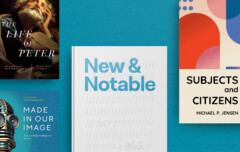There are two ways to read the Bible. The first way to read it is as a series of stories, books, statements, and teachings that are fragmented and disjointed, that, though they have little relationship to one another, have been compiled into an errant and fallible collection. The other way is to read it as a consistent, connected, and consecutive work that tells one cohesive story. When we read it this way, we see that Genesis is as connected to Revelation as it is to Exodus, that the ending perfectly complements and completes the beginning. When we accept it like this, we understand it as it truly is.
I’d love for you to read this lovely piece of writing by Theodore Cuyler who explains how we ought to read God’s Word—how we ought to read the story of how God is at work in this world to save his people and bring glory to his name. Read it and be blessed!
Some people regard the Word of God as a mere miscellaneous collection of disjointed fragments. They could not make a greater mistake. The Bible is as thoroughly connected and consecutive a work as Bunyan’s “Pilgrim,” or Bancroft’s History. The whole composition hangs together like a fleece of wool.
It begins with the creation of the world; it ends with the winding-up of all earthly things and the opening scenes of the endless hereafter. The Old Testament is the majestic vestibule through which we enter the matchless Parthenon of the New. It is mainly the history of God’s covenant people. Through all this history of nearly forty centuries are interspersed the sublime conversations of Job, the pithy proverbs of Solomon, and the predictions of the Prophets. We hear, at their proper intervals, the timbrel of Miriam, the harp of the Psalmist, the plaintive viol of Jeremiah, and the sonorous trumpets of Isaiah and Habakkuk.
Through all the Old Testament there flows one warm and mighty current—like the warm river of the Gulfstream through the Atlantic—setting towards Jesus Christ. In Genesis he appears as the seed of the woman that should bruise the serpent’s head; the smoke of Abel’s altar points towards him; the blood that stains the Jewish lintels on the night of the Exodus is but a type of the Lamb of God that taketh away the sin of the world; Moses and the prophets testify of Jesus. Just as the rich musical blast of an Alpine horn on the Wengern is echoed back from the peaks of the Jungfrau, so every verse of the fifty-third chapter of Isaiah is echoed in the New Testament of Immanuel.
After a silence of four hundred years, the New Testament begins—and with the genealogy of the incarnate Savior. The first four books are occupied with the earthly life and sacrificial death and resurrection and ascension of the same Personage. The four independent narratives of the evangelists—like the four walls of a church edifice—contain and enclose the complete narrative of Christ’s life. Each one has its place and its purpose. Matthew wrote for the Jews, and in his gospel Christ is represented as a king; the book describes his kingdom and its laws. Mark describes his wondrous deeds as the man of action—the Christ as a servant doing his Father’s will. Luke wrote for the Gentiles, and of Jesus as the Son of Man. John occupies his rich aromatic pages with the wonderful words of the Son of God. He defines his special object at the close of his twentieth chapter: “These are written that ye may believe that Jesus is the Christ, the Son of God, and that believing ye might have life through his name.”
The biographies of Jesus are completed, but not his life upon earth. The next book carries it forward. He still lives by his Spirit in the chosen Apostles. The Book of the Acts written by Luke, commences with these words—“The former treatise have I made, O Theophilus, of all that Jesus began to do and to teach.” This second treatise simply continues to narrate what Christ does and teaches through his Apostles and representatives. It is devoted to the founding of Christian churches in certain great centers of influence, like Jerusalem, Antioch, Ephesus, Corinth and Rome. The churches thus founded must next be instructed in the commandments of their Lord and be indoctrinated in the practical principles of holy living. Hence arises a necessity for the Epistles. Each has its province. The epistle to the Romans is the grand argument for justification by faith. That to the Galatians treats of deliverance from the bondage of the law. The letter to the Philippians is redolent of gratitude and of joy in hours of trouble. Its motto is “gaudeo; gaudete!” The epistle to the Ephesians is the setting forth of the “heavenlies;” that to Philemon is the charter of human rights and the seed of emancipation-proclamations; the epistles to the Corinthians are manuals for personal conduct and the government of churches. When Paul wrote to Timothy and to Titus, he furnished manuals for Christian pastors. John’s epistles are all love letters—the effusive sweetness of the heart’s honeycomb. When Apollos penned the Epistle to the Hebrews (as I am inclined to believe that he did) he set forth the priestly office of Jesus and the blessings of personal faith. Peter utters the practical precepts and warnings that are needed not only by the dispersed disciples, but by all disciples to the end of time.
When the life, the death, and the mighty works and divine instruction of Christ (by his Apostles) have been completed, there bursts upon us the magnificent panorama of the Apocalypse. This is the book of sublime mysteries. But through all the apparent confusions of thrones and of armies, of thunders and lightnings, of trumpets and viols and winged angels, we can distinctly trace the progress of the final conflict between King Jesus and the powers of darkness. The long battle terminates in the overthrow of Satan, and the glorious victory of him who wears on his head the many crowns. Then comes the final resurrection of the dead, the general Judgment, the revelation of the New Jerusalem, prepared for the endless habitation of the redeemed. The Apocalypse closes with its seven-fold chorus of hallelujahs and harping symphonies.
Such is the wondrous volume which God has given to man, and which outweighs all the libraries on the globe. It contains many writings, yet is it but one book. It has many writers, yet it is all from one Author, the Almighty Spirit of God. The pure, white, spotless fleece hath throughout its connecting fibers; the fabric is divine in its origin, its unity, and its imperishable power and glory.










